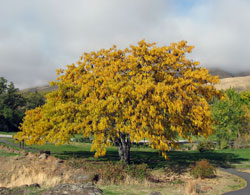Honeylocusts (Gleditsia spp.) are widely planted as landscape trees along the Front Range.
Why do the honeylocust look thin?
In recent years, many honeylocust canopies look thin due to fewer and smaller leaves combined with dieback of twigs and branches. 
What can cause stress to honeylocusts?
Honeylocusts have experienced several stresses over the past few years – dry winters, hail injury, spider mites, honeylocust plant bug injury and late spring freezes that damaged new leaves. These stresses may have become cumulative, affecting tree health.
What should I do to my affected honeylocust?
Homeowners with affected honeylocusts should have dead wood pruned out by September. In addition to “normal’ growing season watering, water should be applied to the soil at the drip line and beyond during warm dry periods in late fall/winter.
Stressed/affected honeylocusts are more prone to attack by borers.
For more information, see CSU Extension fact sheets:
- Insect and Mite Pests of Honeylocust
- Honeylocust Diseases
- Healthy Roots and Healthy Trees
- Fall and Winter Watering



